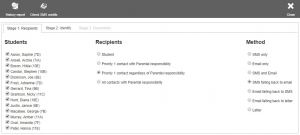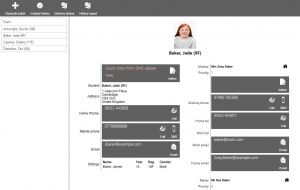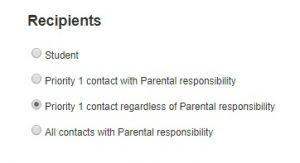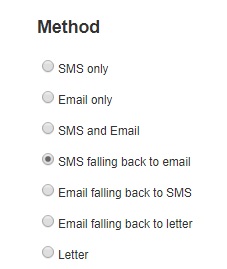Test
This page is used to send messages via email or SMS, and to generate letters. This page can also be used to record the details of phone calls and meetings. All of this information is saved on the student's contact log.
Contents
Accessing the External Contact screen
There are a variety of reasons you may want to contact parents from PARS. The External Contact page is always used to send the messages, but the method for accessing the External Contact page changes, depending on the reason you are contacting parents.
The following permissions are required to access the External Contact page:
Contact management > Access notices management screen (On)
Contact management > Manage and review external communications (On)
For General Messages
The page is simply accessed via:
Main Menu > Contact Management > External contact
You can also click the External Contact button on the Quick Launch Bar at the top of PARS.

For Absence
You should use the Attendance View page to identify the absent students (see the Attendance View page for instructions to do this). You would then click Contact > External Contact on the Attendance View page.
For Behaviour Incidents
This is to contact parents about individual behaviour incidents i.e. contact all the parents of students who received a Head Teacher's Award this week; contact all the parents of students who received a C4 today; etc. Parents receive one message per behaviour incident and the messages can include information about the behaviour incidents, such as the grounds or the comments.
The Edit Behaviour Incidents page is used to select the behaviour incidents for which you will contact parents (see the Edit Behaviour Incidents page for instructions to do this). You would then click the External Contact button on the Edit Behaviour Incidents page.
For Detentions
This is to contact parents about specific detentions. The messages sent to parents can include information such as the reason that the detention was given, or the date and time it is going to take place.
The Edit Scheduled Detentions page is used to select the detentions for which you will contact parents (see the Edit Scheduled Detentions page for instructions to do this). You would then click the External Contact button on the Edit Scheduled Detentions page.
For Assignments (Homework)
You can contact parents about a homework assignment, either to notify the parents and/or students that a homework has been set (and email any attachments). Alternatively you can notify the parents of students who have not completed the homework.
Open the Assignment Diary and select the Assignment, then click the External Contact button. See the Assignment Diary page for more information.
For Low Attendance
You first need to run an Attendance Report to identify the students with low attendance (e.g. lower than 85%). Attendance Summaries > Individual Percentages > Selected Individual Session Attendance is a good report for this purpose.
Attendance Reports are accessed via:
Main Menu > Attendance > Attendance Reports
The report then needs to be filtered to show only those students with less than a certain percentage attendance. The Reports page explains how to filter reports. Once the report is filtered click the External Contact button at the top of the report.
Using the External Contact Screen
Batch send messages / batch generate letters
Click the generate batch button at the top left of the page. You will be taken to a new page with 3 tabs.
Stage 1
On the left side of the page you will see a list of students whose parents are to be contacted. Deselect any students whose parents you do not want to contact.
In the middle column select the type of person you are going to contact. There are four options:
- Students
Contact the students themselves. Emails will be sent to their 'work' email addresses (as set in SIMS)
- Priority 1 contact with Parental responsibility
Contact people who are both priority 1 and have parental responsibility
- Priority 1 contact regardless of Parental responsibility
Contact people who are priority 1
- All contacts with Parental responsibility
Contact people who have responsibility
On the right side of the page select the method you wish to use to send your messages. Some of the options include the phrase falling back to. In these cases, the second method will only be used if the recipient does not have any details to use for the first method e.g. When SMS falling back to email is selected, parents will only receive an email if they do not have an SMS number in SIMS.
Note that there are some settings that will affect the options shown on this tab. If some options appear to be different or missing, see the Frequently Asked Questions section of this page.
Stage 2
This tab will check that, for each student, there is a person in SIMS who can be contacted based on the options selected on the previous tab.
Each student will be listed and any valid contacts (according to their Priority Number and Parental Responsibility) will be shown next to the student. Students are highlighted in red if they cannot be contacted for any reason.
- If a student has a contact with a Court Order, the contact's name will appear with a warning symbol. By default contacts with Court Orders will not be contact. See Archie Ansell above.
- If a student does not have any contacts with valid Priority and/or Parental Responsibility, then no names will appear next to the student's name. See Adrienne Frost above.
- If a student has a valid contact but that contact does not have appropriate contact details (e.g. no SMS number or no email address) then the contact's name will appear with a black icon. See Hilda Boson above.
Stage 3
This tab is used to enter the message that will be sent. If you have messages saved in the message bank, dropdowns will appear allowing you to select these messages. Click the relevant button (Email, SMS or Letter) to edit your template message or manually compose a message.
For instructions to add messages to the message bank, see the Message Bank section of this page.
After clicking the SMS, Email or Letter buttons, a Compose Message window will open. You can add merge fields to your message by clicking Insert > Field > .... When sending Emails or SMS messages, there is a Send at field which is used to delay sending the messages until a later time. This can be useful when sending large volumes of emails. When sending Emails you will see an additional tab to add attachments to your email. Every recipient will receive the same attachment(s).
If your letter includes General Attendance or General Behaviour merge fields, a Range button will appear on the top toolbar. This button is used to select the date range from which the attendance data will be gathered.
When sending a letter there is an option to Upload a copy of the letter to the student's linked documents in SIMS.
Click the Generate button at the top left of the screen to send your messages or download your letters.
Sending single messages and recording phone calls
The External Contact screen has two 'modes'; the normal External Contact screen and the Batch Sending screen. If you can see three tabs labelled "Stage 1", "Stage 2" and "Stage 3 you are on the Batch Sending screen. Click Close at the top right to access the normal External Contact screen.
You will see a list of students on the left side of the page. The External Contact page shows the details of one student (and their parents) at a time. Click on a student's name on the left to view that student's details.
The student's own details are listed on the left side of the page, such as the student's email address and the student's mobile telephone number. These details are taken from Section 3 and Section 4 of the Student Details page in SIMS. On the right the student's parents' details are displayed. This information is taken from Section 5 of the Student Details page in SIMS.
Send single message
To send a message, find the email address or mobile telephone number you want to use and click the Email or SMS button next to it. This will open a window where you can compose your message. You can access the message bank by clicking Insert > Template. Click Send when finished.
Record meetings or phone calls
For telephone calls, find the telephone number that was used then click the Call button next to it. A window will appear in which you can type the details of your phone call. There is a Contact type dropdown near the top of the window. This is used to record whether the call was successful, or whether there was no answer, a voicemail was left, etc.
For meetings click the Ad-Hoc button next to the contact's name. A window will appear where you can type the details of the meeting.
When recording meetings and telephone calls most information will be recorded on the contact log. This includes the date, time, the name of the staff member recording the information, the person contacted and the student. In the case of telephone calls the telephone number is also recorded.
View contact log
All emails, SMS messages and letters sent by PARS are automatically recorded on the student's contact log. Any telephone calls and meetings are also recorded on the contact log.
There Contact History and History Report buttons are used to access a student's contact log.
Contact History shows a summary of contacts made, but to see the details of each contact you must click the view button (this is the button that looks like a sheet of paper). This report is easier to read at a glance but requires more clicks to see the details of a message. The Contact History report can also be used to edit and delete items from the contact log, using the pencil and cross buttons.
The History Report shows all information from the contact log. It is not possible to view the details of letters using this report. Items on the contact log cannot be edited or deleted using this report.
There are two other methods for accessing the contact log outside of the External Contact page. Contact Reports are available via:
Main menu > Contact management > Contact reports
An individual student's contact log can also be viewed in the Pupil Information screen. This is accessed by clicking the Pupil Information button on the PARS quick launch bar.
Configuration
Emails
SMTP details
In order to send emails, PARS needs to be given the SMTP details of your email server. These settings are entered into PARS via:
Main menu > System management > Preferences > Email
At the bottom of this section there is a Send Test Email link which you can use to test the details you have entered. We cannot tell you what these details are; if you do not know your SMTP details, you must find them yourself.
Email replies
By default email replies will be sent to the From Address listed in the email preferences (Main menu > System management > Preferences > Email). If you would like users to receive email replies to their own email address instead, each user will need the following permission enabled:
Contact management > Use own email address as email reply address if available (On)
SMS
SMS Account
In order to send SMS messages you must have an account with TextAnywhere and enter those account details into PARS. If the details have not been entered into PARS you will not be able to select SMS as a method of contact.
The details of your TextAnywhere account are entered into PARS via:
Main menu > Contact management > Configure > Configure SMS
Clicking the here link on the Configure SMS page will take you to TextAnywhere's website.
SMS replies
Replies to SMS messages will be sent as emails. The reply emails can be sent to a central email address, to the person that sent the SMS, or both. To decide where the replies will be sent, go to:
Main menu > System management > System > Automation
Note - to access this screen you need the following permissions:
Automation > Access automation control (On)
Automation > Setup automation jobs (On)
System management > Access PARS management options (On)
Click on the Jobs tab at the top of the page. You will see a list of the automatic tasks that PARS performs. Look for a row on this page called Check for, and send outstanding batch SMS messages. Click the Magnifying Glass next to this row.
Enable the Email originator option for the sender of the SMS messages to receive replies to their own email inbox.
Enable the Email this address option for email replies to be sent to a central email address. You will also need to enter the email address you want to use.
The Add details of SMS's option should be enabled. Also make sure that every day of the week is ticked. Once done, click OK.
Message Banks
PARS allows the use of Message Banks so that you can pre-configure message templates to be used on the External Contact page.
The Message Banks are accessed via:
Main menu > Contact management > Configure > Email / SMS / Letter message bank
Note to access these screens you need the following permissions:
Contact management > Access notices management screen (On)
Contact management > Allow access to contact management comment bank (On)
All existing message templates will appear on the screen. Click the Add button to create a new message template.
A Compose Message window will open in which you can type your message. You can add merge fields to your message by clicking Insert > Field > .... Images can be added to Email or Letter templates by clicking Insert > Image.
Frequently Asked Questions
One or more of my templates is not available when composing a message
This will happen if your template contains merge fields that are not valid for the type of message you are sending. For example, your template may contain the merge field {{TYPE}}. This field refers to the type of detention that a pupil has been given. Therefore it does not make sense to use this template message unless you are sending a message about detentions.
So if your template is not available, it is for one of the two following reasons:
- You have an incorrect merge field in your template. Edit the template and remove the offending merge field(s). See the Message Banks section of this page for information regarding the configuration of Message Bank templates.
- You are accessing the External Contact page using the wrong method. See the Accessing the External Contact screen section of this page for further instructions.
Some options are missing from the Stage 1 tab when sending a batch message
You may find that some options are missing from either the Recipients section or from the Method section.
Recipients
Up to four options can be shown in this section. Your permissions define which options are shown here. "Students" will always be visible in the Recipients section. This option is used to contact the students themselves. The additional three options are controlled by permissions.
Priority 1 contact with Parental responsibility
The permission needed to access this option is:
Contact management > User can contact highest priority parent (On)
Priority 1 contact regardless of Parental responsibility
The permission needed to access this option is:
Contact management > User can contact highest priority contacts (On)
All contacts with Parental responsibility
The permission needed to access this option is:
Contact management > User can contact all parents (On)
Method
The Letter option will always be available. Any of the options involving Email or SMS may be hidden for the following reasons.
Email - The user does not have sufficient permissions
The permission needed to access this option is:
Contact management > Prevents user from sending emails (Off)
SMS - The user does not have sufficient permissions
The permission needed to access this option is:
Contact management > Prevents user from sending SMS messages (Off)
SMS - PARS has not been given the details of your TextAnywhere account, used to send emails
You need to create an account with TextAnywhere and enter the account details into PARS in order to send SMS messages. See the





